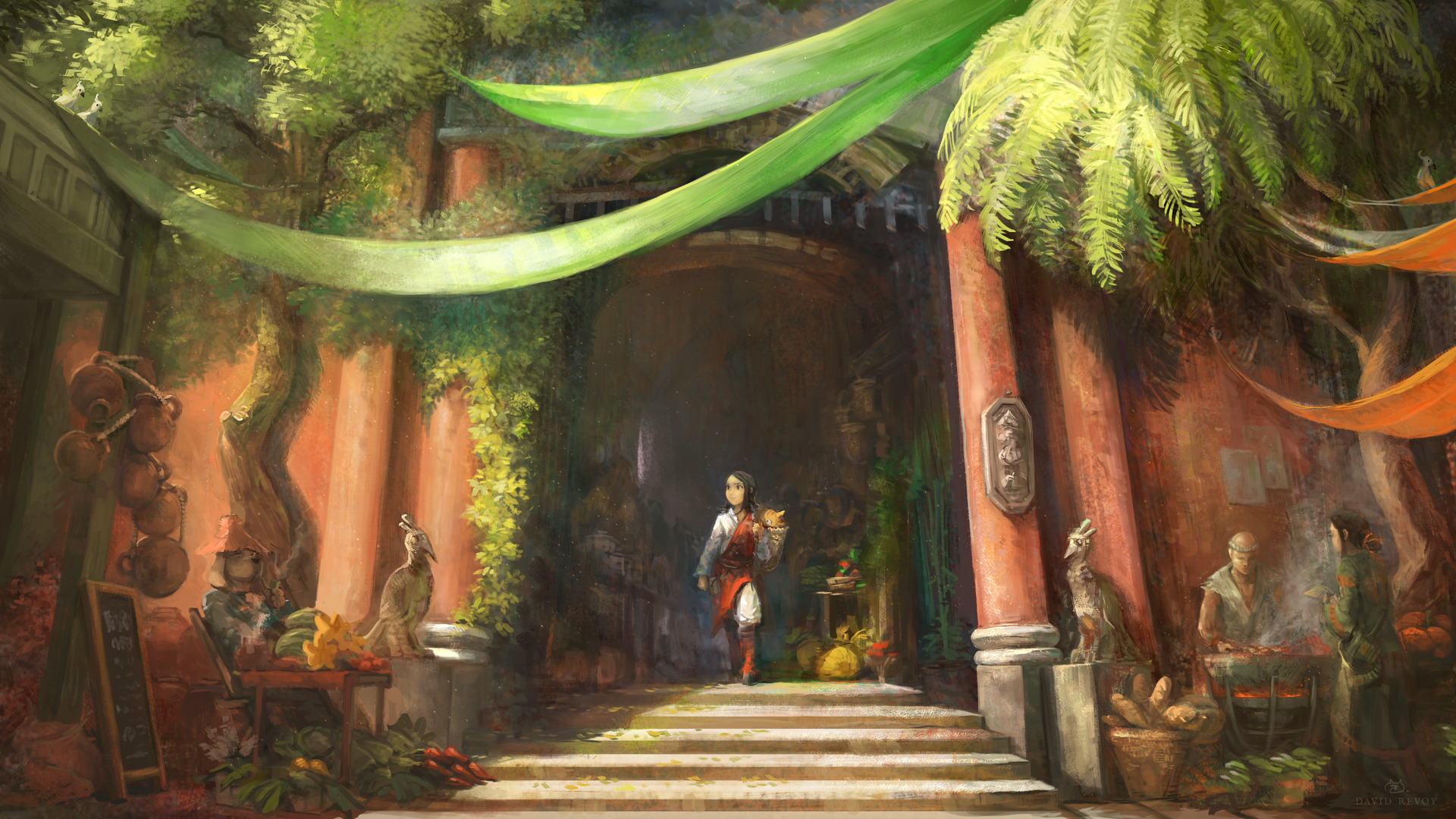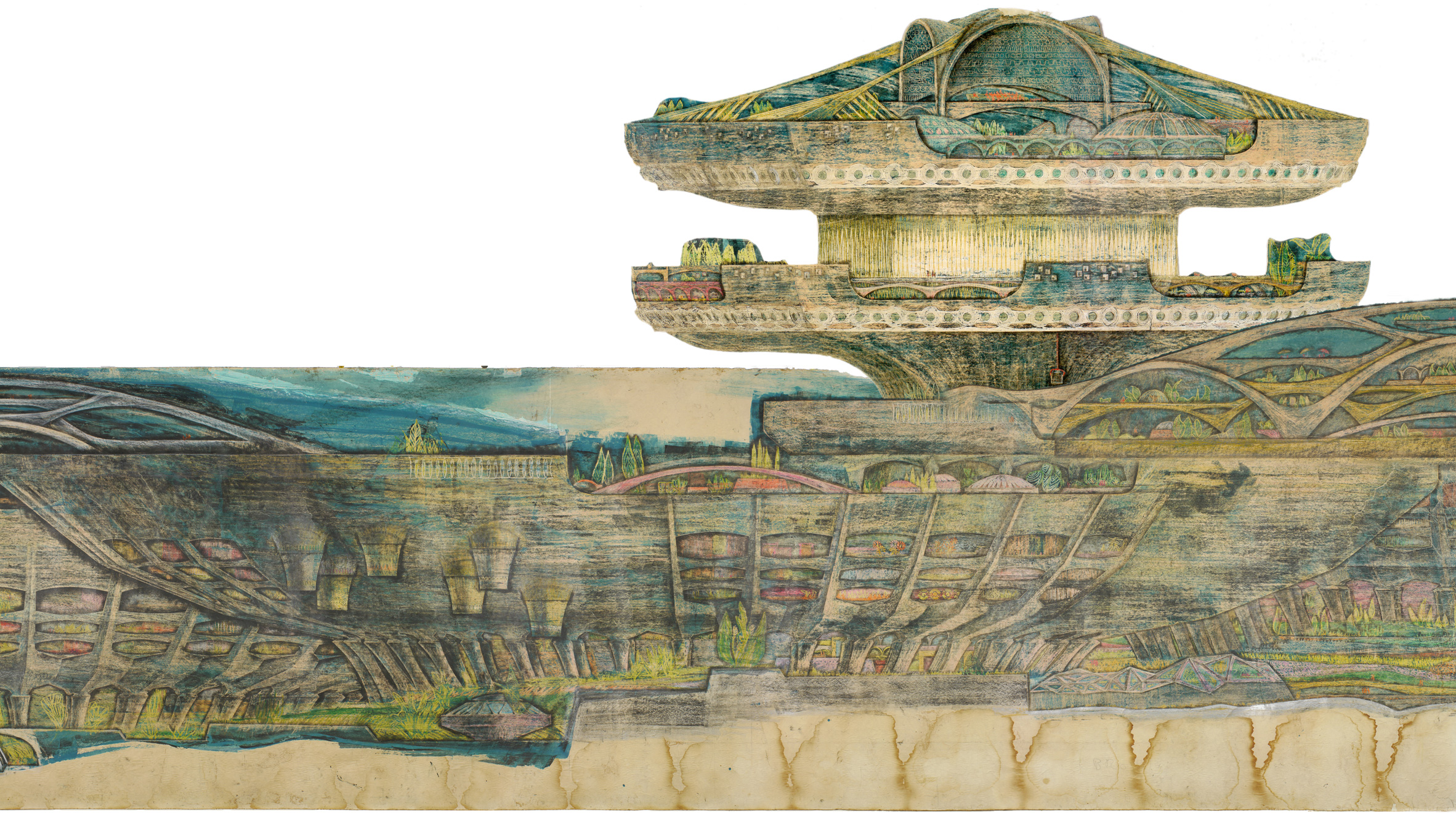I’ve been thinking a lot about how lifestyles, routines, and the overall pace of life might be different in a more solarpunk society. That, combined with some recent discussions and research into solar cookers made me want to try a scene of a solarpunk kitchen.
Specifically, I decided to render a summer kitchen, a fixture of old farmhouses around here, usually slung between the house and the barn, just a place where you could cook without heating up the rest of the house. They fell out of favor as stoves got more efficient, and they're a luxury for people with lots of space, but I think there's value in a spot where we can cook without making air-conditioning fight the oven. Seasonality may play a much bigger role in our lives in a more solarpunk world.
I pictured our summer kitchen as a kind of three-season porch or sunroom, somewhere you could grow herbs in the windows and overwinter less-hearty fruit trees. And maybe as we reconsider cooking around slower processes, in less hectic lives, add some seating for company (conventional wisdom has it that they're gonna hang around your kitchen either way, so we might as well build the space with that in mind). By building one wall mostly out of sliding doors (with bug netting I didn’t bother to show) we can open the space to cool it, and to reduce any risk of humidity building up from the greenhouse part and rotting the house.
There are a few benefits to this design, I think – in addition to cooling, by building the summer kitchen as an outcropping from the house, we add options for north-facing sides to point our south-facing Scheffler reflector at, making it easier to retrofit old houses. And if we have a south wall to work with, we can add a proper greenhouse wall to get the most out of our natural light. And if we’re building an addition anyways, we can add a root cellar underneath, for preserving vegetables and some fruits without the use of electricity.
Once I had a basic layout in mind, I turned to the folks on the solarpunk community and included as many of their ideas as I could.
So, features of this kitchen of the future:
Solar oven: I borrowed the design (and the reflector) from Tamara Solar Kitchen. The big dish beside the house uses the curved, parabolic mirrors to concentrate light on a small opening on the firebrick north wall of the summer kitchen. This light bounces off an angled mirror so it enters the oven from underneath, allowing you to bake in the brick oven, or use the cast iron plate set into the top as a stovetop.
Several of these devices exist IRL and work just fine with only manual controls. But I included the computer control panel because I wanted to show that despite some of my other pictures and their emphasis on analog designs, there's a place for technology in a solarpunk society. Modern tech, without the corporate surveillance state, and focus on wasteful extraction, is a huge part of what I think can make solarpunk work. A lot of the older technologies I'm reexamining may benefit from or become viable with better sensors and automation.
For the screens, my head cannon is that they're old, out-of-support tablets, and the co-op that makes these setups flashed them with a custom ROM, essentially turning unsupported, insecureable tablets into secure, single-purpose devices. Making them less generally useful, perhaps, but still extending their service life far beyond what their manufacturer intended. A motoring system that helps you keep track of your mirror and makes sure it’s not cooking the wrong part of your house would be a good thing to have.
Solar hot water: on the roof, another opportunity to use sunlight directly, and to make the most of our south-facing roof.
Pedal-powered appliances: This was a recommendation from the instance which would not have occurred to me, though I’ve used old pedal-powered grindstones before. I built these ones into the bar both because it made for easy access/maintenance, and because I wonder what 'keeping up with the Joneses' looks like in a solarpunk future, I think in any society, no matter what its values are, there will be people who go way out of their way to demonstrate those values, and I could see things like this being used as statements. This is largely remixed from a real thing a design student made, though I modified the pedal system so it would use a step set under the counter, rather than the version that stuck out the side, as I felt like I’d kick that thing whenever I walked past the bar.
Root cellar: another idea from the group, and something the people living here could benefit from all year long. You might notice that the refrigerator is missing. We talked a bit about perhaps modifying a propane-driven camper fridge to run off a solar cooker, but ultimately I decided they probably have one refrigerator, maybe set up like a chest freezer for maximum efficiency, back inside the winter kitchen.
Fermenting kit: another option for preservation and a fun hobby and another idea from the group. They might be making beer, or soy sauce, or any of a bunch of things. Similarly, I included a shoebox tempeh incubator on the counter as well.
As for making the image itself, these more realistic-looking ones take a lot more time as I can’t rely on filters or other stylizations to hide details. But I wanted this one to be detailed. While I was planning this one, I referenced some of the AI art out there of solarpunk kitchens for visuals I liked – the very fancy dark wood, red accent walls, and bright sunlight streaming in were elements I reused here. But one thing I think that sets this apart, besides the ideas I want to demonstrate, is that you can zoom in on this and really look at the bits and pieces, and they hopefully make sense. Someone (me) had to find and cut out all the jars and plants and nicknacks. There’s a reason that they’re there. Hopefully the version of the image you’re seeing still has enough detail to allow you to do that, if not let me know and I’ll find a way to send the high rez version.
I’ll say here that the stained glass windows and the carved wood panels were contributed by a friend’s midjourny bot.
One last note: buildings in a solarpunk world are going to vary drastically based on local conditions. Building in cooperation with our surroundings is one way to really cut our consumption of resources. This kitchen is built for North America because that’s what I know. Other continents, other longitudes, other climates, will call for much different designs. I’d love to see those if anyone can depict them.
And, like the other Postcards from a Solarpunk Future, this image is CC-BY, meaning you can use it for whatever you like. I'm not sure how, in-world, this ended up as a postcard, maybe the homeowners won a contest or made it to the cover of a homesteading zine or something.









